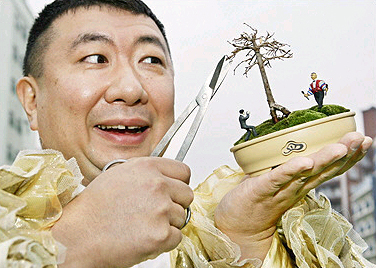
Make sure that the document extension is .php and that your server supports PHP documents.
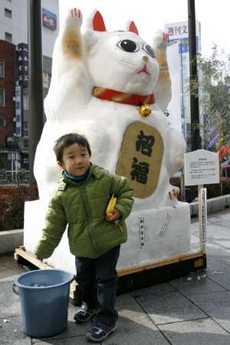
Before my Hiroshima correspondent, ironically enough, suffered an infelicity at the lens-end of a camera, I was acquainted with Maneki Neko, the white "beckoning cat" whose porcelain likeness is said to invite fortune to Japanese business establishments. The pet of a temple curate, goes the legend, saved the life of a nobleman in such a miraculous way that the lord bowed to the gods and granted, for the impoverished priest, a generous boon.
Belief in the significance of Maneki Neko pervades. It was indirectly confirmed to me that a walk through a commercial district will yield several sightings of a thickset, white feline cordially raising one or both paws. Left up, patrons are welcomed; right up, earnings and profit are embraced. When both front legs are up in the air, a request for protection is submitted. The snowman built up on a Tokyo street might have been a petition for less wintry weather, though possibly for more. This is superstition: either way the season turns, there sits Maneki Neko in the middle of timely happenstance.
My Hiroshima correspondent sent a dispatch after she was accosted by the downtown sights and sales of the annual Yebisu Festival.
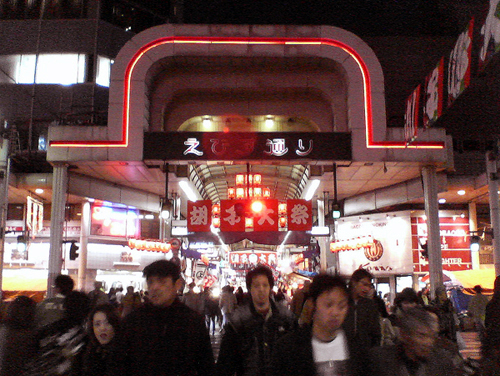
As she tells it, this photograph was taken at the intersection of Yebisu Dori and Chuo Dori the instant the crosswalk turned green.
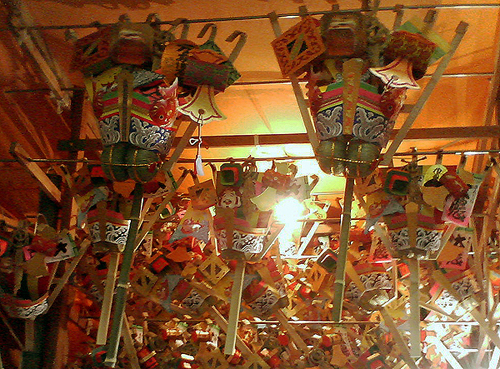
Green — economic if not chromatic — is what adorns the celebration, Yebisu being the resident god of commerce. "Trying to earn a little financial luck in the year to come," I am told, "everyone goes out and buys little ceremonial rakes." Why? "Because apparently you can't 'rake it in' if you don't have one." Craftsmen and merchants, one surmises, are among the devout.
This modest publication's cosmopolitanist feature, "Only in Japan," has lain dormant for lack of suitably peculiar slices of Japanese life — at least from the volumes of photo-journalism.
Why not freelance? Providentially, Figure Concord recently gained a Hiroshima correspondent. An American expatriate equipped with a demonstrably advanced cell phone camera and a sharp sense of amusing cultural differences, this source may provide us, over the months, an occasional look at what we all expect to see from Japan: matchless oddity. The captions are hers.

A new spin on "His & Hers."

[What appears to be a Doraemon six-string] for your guitar collection.
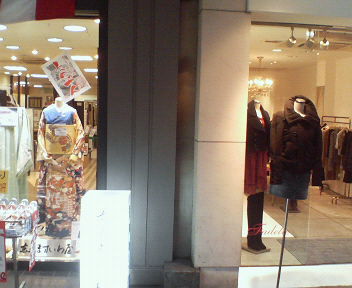
Dichotomy.
In appropriate thanks — and correct, having verified — arigatou.

We regard the genial fast-food worker — overalls and paper garrison cap, standing between counter and kitchen, offering with both hands a meat product cooked in less time than it takes to boil water — as having become parodical tableau some twenty-five years back. With a little effort the inculcated grin can be restrained and the value of a cheap lunch or even a high school income, exclusive to liberal modernity, recognized. And then we grin.

After a two-year moratorium on account of mad cow disease, dining colossus Yoshinoya D&C Company celebrated the resumption of American beef imports with a Tokyo press conference, its beef-and-rice dish the centerpiece. Company President Shuji Abe was probably well aware of humor associated with his industry when he plucked the contents of a meal from a ceramic bowl but, looking to sales predictions showing not the slightest loss of interest from the product's suspension, had reason to smile himself.

With the 1982 theatrical release of Ridley Scott's Blade Runner came eclecticism, its strobe-and-neon frenzy of commerce and urban bustle providing science fiction writers and producers with a thematic additive, even an alternative, to the traditional utopia-dystopia dichotomy. If today, compared to yesterday's notion of the future, is a result of prophecy or contrivance we might wish to debate, for here is a sight not far removed from that which was once built by Hollywood stagehands: in Tokyo, the placid venerability of Noh theater amid downtown's skyward panoply.
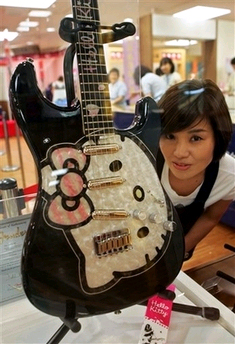
Brat-pop rockers for want of endearing, onstage commercial flair can stop looking: the Mitsui Group's chain emporium, Mitsukoshi Ltd., has set a rare Hello Kitty-stamped Fender Stratocaster out on the counter. The guitar's pickups, bridge, and volume and tone controls intrude a bit on the cartoon feline's minimalist outlines; players may also find it disconcerting, in using Hello Kitty's jaw as a pickguard, to have gradually engraved a smirk. Against this are the possibilities for fret marking raised by a nacre-white, cursive signature running down the neck.
A price tag of $21,000 will keep the instrument out of reach of all but wealthy and larcenist dilettantes. And while stars have the cash, style may be a restraint. However appropriate Kitty's bubbly insouciance might be for, say, the diminutive Angus Young and his scrubbed schoolboy uniform, it would never happen — AC/DC's lead guitarist, don't you know, only plays a Gibson SG.
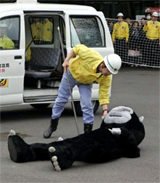
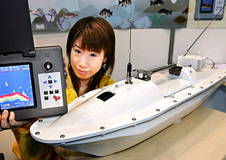
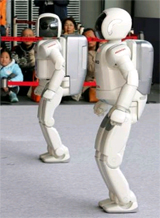
Simulation means "near verity," which can be understood as "not quite real," and in Japan that is taken as permission for artistic liberty: so an ersatz gorilla shall be drawn straight from the morphology of Nintendo. But verisimilitude is near enough, and a funny-faced fugitive ape is treated as just as dangerous — to be kept away from steel platforms, blondes and barrels.
Fishermen can cheat in a modern style as waterborne pointer Kamome tags schools like a submarine spotter. No need to fib afterwards: Kamome let it get away!
And after twelve months' gestation, the Honda Motor Company has announced its delivery of Asimo the Second — in robotic aristocracy, however, it is the penultimate son who is consigned to heir presumptive. New Asimo is faster, more dextrous; closer to the design ideal. The first astronaut-like robot stands alongside its successor in public exhibits, if only to dramatize progress in humanoid articulation by way of inferiority. Still, old Asimo — and the Second, when it too is superseded — will remain on Honda's escutcheon. Machines recede in obsolescence but are never lost, safeguarded in museums and picture books, granted the title "vintage" or "classic"; thanks to their human keepers' compassion for antiquity.

Yes, of course, a boy has only two shoulders over which peers can gape, but a crowd of young Kabuki actors backstage at the Edo-Tokyo Museum formed a dehiscent triad behind a handheld video game — showing just how bright and fluid pixels illuminate a child's face and mind. The device has no identification; the expressions require none. On our left, desire and the right, wonder. In the center, that unforgettable, inexplicable rapture of fixed captivation.
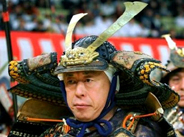


There is remembrance, rapport and conciliation in Japan. Costumiers furnished period dress in a celebration of the New Year through that which is now one hundred thirty years old; Tokyo shoppers were treated to a quartet of zoologically necessary best friends engaged in a fiduciary canter; and at the Mutsugoro Okoku Zoo in Tokyo, the wolf (in this case, a ratsnake) dwelt with the lamb (correspondingly, a dwarf hamster).
After Santa Claus' arrival in Osaka by sea, press pool photographs from Japan were stricken with a discomfiting normalcy and for weeks this series languished. With the New Year come celebrations and with celebrations, customs — and in Japan, Tokyo firefighters perched on bamboo poles, atavistic ballgames in Kyoto and kimonos on the Nikkei floor.

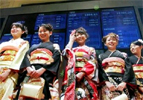
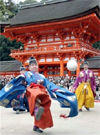
Dearest Japan, how we missed you.

If imitation is a gesture of admiration, synthesis is a fecund marriage of emulation and interpretation. The Japanese celebrate Christmas with every ounce of supply-side jolity as the broader American observance — while adding to the holiday a few of their own distinguishing characteristics. When Yuletide arrives, Santa scubas.
Cue Entrance of the Gladiators. The 39th Tokyo Motor Show, a fortnight-long world revelation of all things that roll on motor-driven variations of the wheel and axle, is now underway. Japanese designers often proceed uninterrupted from laboratory logic to the convention dais, form following uninhibited intent so closely that the showpiece is what many other designers would be content to leave as a curious maquette, a paperweight, on the edge of their desks or drawing boards, safe inside the office — too embarrassed to present straight out of the sketchbook. For Japan's automobile industry, then, there is éclat in a thoroughly ludicrous concept car.
 Placing a bag of flour on top of a cutting board and two rolling pins normally results in Mother's praise and polite request for the missing items' eventual return. Nissan tried it and got "Pivo." An electric-powered people-mover, Pivo's distinction is its bulbous, revolving cabin which shall, the car company promises, bring an end to terms such as "hood" and "trunk" — and the need to back out of a driveway. When scuttling about town, families of three will be pleasantly acquainted with doubly large windows and the element of yaw. On which side does one fasten bumper stickers? Both; you may now choose twice as many. What happens when the cockpit swivels perpendicular or opposite to Pivo's forward bearing while on the interstate? Ensuing high-velocity hilarity. The car's wheels do not allow for horizontal motion, so parallel parking will remain an automotive tradition.
Placing a bag of flour on top of a cutting board and two rolling pins normally results in Mother's praise and polite request for the missing items' eventual return. Nissan tried it and got "Pivo." An electric-powered people-mover, Pivo's distinction is its bulbous, revolving cabin which shall, the car company promises, bring an end to terms such as "hood" and "trunk" — and the need to back out of a driveway. When scuttling about town, families of three will be pleasantly acquainted with doubly large windows and the element of yaw. On which side does one fasten bumper stickers? Both; you may now choose twice as many. What happens when the cockpit swivels perpendicular or opposite to Pivo's forward bearing while on the interstate? Ensuing high-velocity hilarity. The car's wheels do not allow for horizontal motion, so parallel parking will remain an automotive tradition.
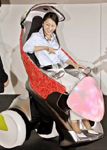 Toyota describes "I-Swing," its roundabout answer to the Segway, as "emotional." The wheeled hair dryer chair is built to reflect its single operator's mood or clothing — feeling fire-engine paisley today? I-Swing can oblige. Intended for pedestrian use the vehicle can simultaneously reach faster speeds and channel Artoo-Deetoo by extending a third, front wheel. The Japanese mentality for robotics is very much at work here: It is reported that Toyota wishes to use "artificial intelligence" for I-Swing's adaptability; and a spokesman referred to the scooter's development as a process of "evolving," rather than "refining." We know that Toyota is excited about I-Swing's transformation of the daily commute. Judging by its prevailing color, is I-Swing?
Toyota describes "I-Swing," its roundabout answer to the Segway, as "emotional." The wheeled hair dryer chair is built to reflect its single operator's mood or clothing — feeling fire-engine paisley today? I-Swing can oblige. Intended for pedestrian use the vehicle can simultaneously reach faster speeds and channel Artoo-Deetoo by extending a third, front wheel. The Japanese mentality for robotics is very much at work here: It is reported that Toyota wishes to use "artificial intelligence" for I-Swing's adaptability; and a spokesman referred to the scooter's development as a process of "evolving," rather than "refining." We know that Toyota is excited about I-Swing's transformation of the daily commute. Judging by its prevailing color, is I-Swing?
 Diphthongs bring a nice cachet to dignified roadsters (ask Rolls Royce), so researchers at Keio University in Tokyo named their creation — the fastest electric car on Earth — "Eliica." Clocking nearly one-third the speed of sound, the eight-wheeler confronts the stigma of battery-powered cars as slow, unmaneuverable and unattractive; while embodying the characteristics of inconvenient refueling and exorbitance. Lead designer Hiroshi Shimizu, seeking commercial and political support, is yet confident that those who want their very own bullet train will have it.
Diphthongs bring a nice cachet to dignified roadsters (ask Rolls Royce), so researchers at Keio University in Tokyo named their creation — the fastest electric car on Earth — "Eliica." Clocking nearly one-third the speed of sound, the eight-wheeler confronts the stigma of battery-powered cars as slow, unmaneuverable and unattractive; while embodying the characteristics of inconvenient refueling and exorbitance. Lead designer Hiroshi Shimizu, seeking commercial and political support, is yet confident that those who want their very own bullet train will have it.
For all of tomorrow seen today at the Motor Show, presenters remained human. This could mean that the bond between car and driver is inseparable — or else there is simply fine-tuning to do before the inevitable. Do androids dream of electric streetrods?
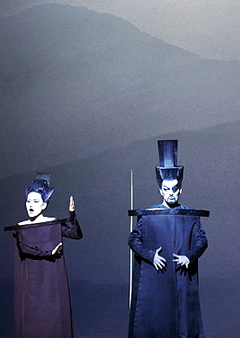
Just days after Junya Watanabe's jagged, lithe Sid Voguish and contemporary aesthetics are again piqued by the Tokyo-Paris axis. German composer Richard Wagner is considered by many — including a friend of mine — to be the pearl come from 19th Century Romantic nacre. How else to immortalize the narrative genius of Wagner's Der Ring des Nibelungen than with world-class voices and unforgettably weird costumes?
The cautious eye finds the opera's principals Mihoko Fujimura (Japan, Fricka) and Jukka Rasilaine (Finland, Wotan) monochromatic, indigo, wearing shower curtains as dickies and atlas-shelf bookends for hats. That silky voice in the backroom atelier of our minds interjects and corrects: No, such muted abstraction is a great tribute, perfect in its contrast (visual minimalism against sonic floridity) and, like all things Apollonian, conceived for timelessness.
CLARIFIATION, JUST BARELY JAPANESE: Fujimura and Rasilaine were rehearsing for a production at Paris' Chatelet Theater.

A taste for the abstruse and, by extension, clothes no one will wear outside of a chic fashion show is the vice shared by all liberal democracies, so the growing reputation of Japanese designer and student of the postwar apparel school Junya Watanabe for widening the rift between art and life can at least be appreciated in terms of solidarity. Or is that commiseration? Watanabe chose this week's Paris festival of pomp to unveil his latest creation that would, said observers, "bring back punk."
 Punk would protest at being doubly misunderstood. Once is preferred, as any upstanding anarchist prides himself on bewildering the establishment with his rebellion; twice is intolerable, for it means the establishment has gotten on fine without him, warmed to the litany of empty calls for revolution and has decided to integrate him in spite of it all. The malcontent is no longer condemned: he is an amusing caricature, perfect for exclusive markets. Anything he yells now only adds to expectation, the quaint little vandal.
Punk would protest at being doubly misunderstood. Once is preferred, as any upstanding anarchist prides himself on bewildering the establishment with his rebellion; twice is intolerable, for it means the establishment has gotten on fine without him, warmed to the litany of empty calls for revolution and has decided to integrate him in spite of it all. The malcontent is no longer condemned: he is an amusing caricature, perfect for exclusive markets. Anything he yells now only adds to expectation, the quaint little vandal.
So Watanabe tailored a set of outfits, taking postmodern loutishness from memory. Feet? Heavy and ponderous black boots. Bottom? Something torn, something black, something white, something red; most of it appropriated. Top? See "bottom." Head? Spiked half-helmets; plastic wrap over the face. The wrap? — oh, that would be Watanabe's own jab at common sense, his nod to the convention of defiance. The eccentric headgear, the overgrown scalp locks, are what seem to have brought the most eyebrows into puzzled misalignment. And? Perhaps they dramatize the first glorious microseconds that follow drilling a hole in the head of the Grecian Discus Thrower, inserting a stick of dynamite, lighting the fuse and stepping back to arm the high-speed camera. Or they could be a 21st-Century answer to the Statue of Liberty — a crown of spires without the Harbor girl's fuddy-duddy uniplanarity. One critic imputed Watanabe's "deconstruction" to politics, though irony would be the better choice, street urchin incorrigibility now swishing up and down a catwalk at a private Paris party.
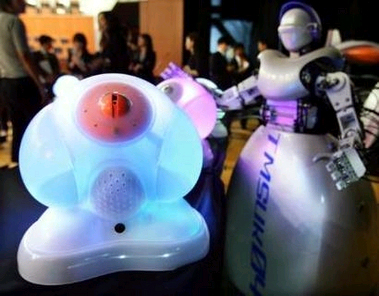
There was the rare and rewarding sighting of an elusive Architeuthis by the Tokyo scientific community's subaquatic paparazzi, a contrived encounter that cost the subject giant squid and gained researchers, journalists and exotic seafood restauranteurs exactly one tentacle — but a collection of Japanese headlines and press pool photographs without robots is like a literary commodities market with no one shouting the price of Holsteins from across the floor.
So we will regard the recent Tokyo presentation by Tmsuk Co., Ltd., former subsidiary of food processing manufacturer Thames Corporation and a youthfully independent Japanese robotics company, whose contributions to man's 21st-Century Pygmalion labor redress Tmsuk's offenses to Western pronunciation. Tim-sook? Ta-missuk? Tmsuk doesn't say, possibly because addressing the company itself becomes less important as one inspects its thirteen-year legacy in — all together, now — working "to create a safe and comfortable society in which people and robots can coexist." In 1993, Tmsuk posted TMSUK-1 at the Thames headquarters front desk as a mobile greeter; TMSUK-2 served tea, chatted about the weather and notified staff when it was due for a recharge, all in a charming dialect. By the end of the decade, Tmsuk produced the bell-skirted TMSUK-4, capable of varying degrees of directed and autonomous movement and activity.
It was TMSUK-4 that introduced Roborior, the company's commercial overture to cutting-edge Japanese households. Christened from a compound of "robot" and "interior," the squat, white, globular machine — oddly cherubic, if with a fleeting resemblance to the lethal excursion pods from 2001: A Space Odyssey — is a likely competitor of Mitsubishi Heavy's Wakamaru. Entryways, valuables and pets are all under the aegis of Roborior, which sends a live video transmission to its masters by cell phone. The unit is said to emit a soft glow, drawing those nearby into "a relaxing mood." Judging from a corresponding pool photograph that phrase may be a euphemism for "trancelike docility." All the better: for over ten thousand dollars more, Wakamaru is programmed to stand guard. If an LED anodyne can prevent the unfortunate burgling of an heirloom, home theater components or even little Gongoro, well then, let intruders see neon pink, blue and purple haze.

Introduced to Japan in February 2002, Microsoft's Xbox gaming console met and conquered the island nation's video entertainment market with all the grandeur and sempiternal glory of Kublai Khan, circa 1274. The Japanese, it turns out, do not care for corporate interlopers and care even less for corporate interlopers with consoles whose game libraries appeal far more to the rather matter-of-fact tastes of Americans. All the zany titles on Nintendo, Sega or Sony arcade systems to which Westerners have pointed and laughed over the years, upon discovery through word of mouth or serendipity, are a very telling exponent of Japanese gaming culture — and the most likely destinations of spending money from Japanese wallets.
The second-generation Xbox 360, scheduled for a rematch with Japanese consumers on December 10th of this year, benefits from four years' insight and a collection of financially didactic bruises. Microsoft is publicly confident, announcing the Xbox 360's victory three months before launch. The Japanese are reportedly still skeptical, four of five turning up their noses in a recent poll held by Famitsu magazine.
So? The men and women working under Bill Gates have always been good at keeping mum, so the software imperium's grand strategy may not be apparent until the Xbox 360 tries to embrace the island with a faceted, aluminium-polymer-silicon grip. But considering the good electoral fortune of Japanese Prime Minister Junichiro Koizumi — whose intrepid campaign to privatize the country's postage-and-savings conglomerate included a head-turning commercial endorsement some ways back — and the above photograph from the Tokyo Game Show 2005, Microsoft is not about to dash a master plan with a breach of foreign etiquette.
Glancing at the morning's site statistics, I noticed half a dozen referrals to the uBlog from a Google Images search for "Peko-Chan." Peko-Chan is the Fujiya Confectionery Company's trademark avatar, a statue of whom stands at the entrance of every Company retail store. When I documented the commercial character eighteen months ago I made a reference, in the press photo caption, to the obvious risks of leaving a jumbo-sized cartoon figurine accessible to the hands of the disreputable, the obsessive or the practically joking.
One look at Google News explained the spate of Peko-Chan entries:
A 39-year-old man was sentenced Wednesday to seven years in prison for stealing Peko-chan dolls, the trademark character for major confectioner Fujiya Co., that are traded at high prices among collectors. Peko-chan, the trademark of confectioner Fujiya Co., welcomes customers at a shop in central Tokyo in this photo taken in April 2004. The company says some 30 of the dolls have been stolen nationwide since January.The Yamagata District Court ruled that Hiroyuki Cho ordered a collaborator to steal 15 life-size dolls, worth about 1.1 million yen in total, from restaurants and shops in Gunma, Saitama and Yamagata prefectures from May to July last year. Cho, unemployed, lives in Takasaki, Gunma Prefecture.
Prosecutors had demanded 11 years in prison as violence was used in some of the attempts to steal the dolls. ...Although Peko-chan dolls are not for sale, they are traded among avid fans, and life-size ones can reportedly fetch more than 100,000 yen.
Two American equivalents are immediately apparent: the stone goose, which resides, in varying seasonal and holiday attire, on the front porch of every craftswoman homemaker; and Bob's Big Boy, which adorns, double-decker burger with everything on it in hand, the front walk of the eponymous restaurant chain; both of which regularly fall prey to pranksters. But neither of those sell for nine hundred dollars on anyone's black market — and no one in the United States will face eleven years behind bars for swiping one (or a dozen). You know the refrain.
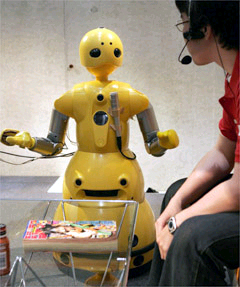
In the tradition of automative humanitarians, Mitsubishi-Heavy Industries Ltd. robot Wakamaru — like a caution-yellow, beveled Two-OneBee — was, as it were, designed and manufactured to serve. Wakamaru is a homebody, capable of visually recognizing those with whom it amicably chats through a lexicon worth ten thousand words, and programmed to assume domestic roles that range from valet to nanny to sentry. Having promoted itself at public events such as the Expo 2005 this past June, the droid is part advocate, too. In the compact and adorable Wakamaru the industry has a propitious example of, as late British humorist Douglas Adams put it, "your plastic pal who's fun to be with." Another distinctive and functional Japanese robot, another cadenza in the vaulting rhetoric of anthropomorphization:
Mitsubishi-Heavy said it would be the first time a robot with communication ability for home use has been sold."This is the opening of an era in which human beings and robots can coexist," it said.
Wakamaru will retail for fifteen grand, so reconciling Household Budget versus Machine may be the first order of business.
HAVE YOUR ROBOT PICKED OUT?: A sci-fi future, according to Extremetech, is a bit closer than previously imagined.
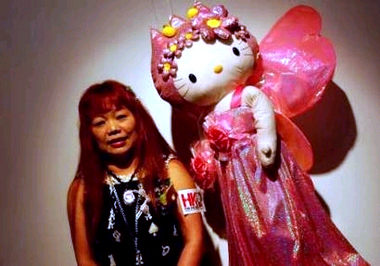
Arrival, Hong Kong; Departure, Japan. Hello Kitty brought a record-breaking crowd, estimated at over one thousand Chinese fans, thundering in to see her "Hide and Seek" exhibition on opening day. What was inside? Hello Kitty — as art, as phenom, as merchandise and merchandise and more merchandise. Pictured above, lead Sanrio designer Yuko Yamaguchi stood by her creation "Fairy Hello Kitty," the latest in redefining a product by catalog number and limited-edition volume. Hello Kitty as mercurial sprite is as good as any illustration for the appeal of a demure cartoon cat heretofore inscrutable: Sanrio leaves a single, subtle variation on an old theme under its pillow for which this pop culture pixie will exchange, overnight, goodness knows how, several million dollars in profit.
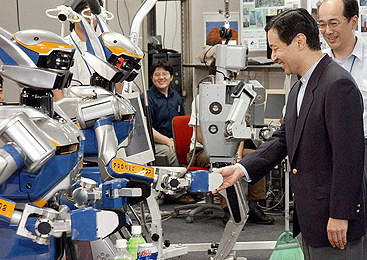
Kawada Industries' metallic marionette HRP-2, or Promet, was built to assist the hands-on replication of individual and cooperative human movements but a soaring profile broadened the robot's purpose, having won an audience with heir apparent to Japan's titular throne, Prince Naruhito. Promet's program must have successfully adopted the niceties of Imperial reception, for the meeting at Tokyo University was reported in the news and the physiological difference between synthetic and organic was duly noted:
[Naruhito] let the robot take several steps toward him to shake his hand, as other humanoids looked on.
Who would pass up a retinue hard-wired for plaudits? Nobody, least of all those who trade in public opinion futures. One wonders if enterprising members of Japan's Liberal Democratic Party, off-balance after failing in the Diet to authorize Prime Minister Junichiro Koizumi's postal privatization reform, are furtively peeking into robotics laboratories — asking questions about the design and deployment of progressive, selfless and loyal politicians for the House of Councillors.
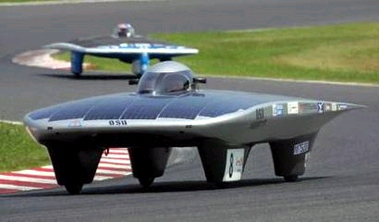
Form follows function, so the multinational visionaries who designed, built and jockeyed solar hot-rods should be proud of the irregular fleet of flattened cupcakes scuttling like oversized dollar-store toys on Japan's Suzuka Circuit at Federation Internationale de l'Automobile's Alternative Energies Cup and Dream Cup race in the name of science. Proving the endurance of vehicles powered by Sol's renewable resources, the eight-hour event was a Jetsons' mockup of the Grand Prix, trading the sexily abrasive roar of internal combustion for the dignified wonderment of an epicene, electric flit. There were adoring fans, breakneck straightaways, pit teams and a requisite champagne dousing at the awards ceremony for champion Ashiya University Solar Car Project A. In its fourteenth year, the Dream Cup met its correspondingly economical objective, "making eco-friendly automobiles." Making them a commercial reality? — no, but surely a curious attraction. Did a robot wave the checkered flag? No? Maybe next year.
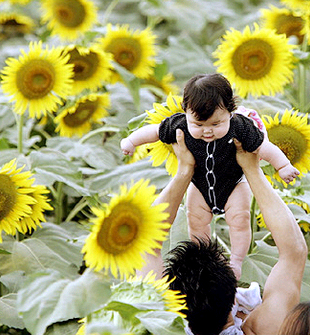
August is sunflower season in Yamanashi Prefecture and for natives and tourists alike, Akeno Village is said to yield two hundred and fifty thousand of the majestic plants for an annual festival. Judging by photographs documenting the attraction over the last several years, visitors seem compelled to brave the botanic crowd that is an enormous sunflower field just nearby the Akeno Flower Center, and commune with nature by being swallowed by it.
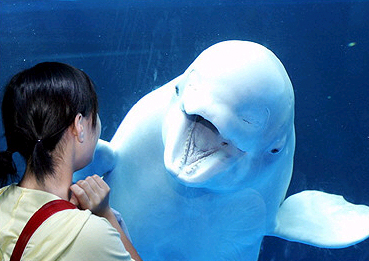
Japan's affinity for colloquial, aquatic creatures is as well-known around the world as it is documented on uBlog (namely here, here and here). Tokyo's Hakkeijima Sea Paradise hosts the Beluga Whale, a chatty underwater beast dubbed the "sea canary" for its acrobatic vocal chords and irrepressible urge to sing, sing, sing. This specimen of Delphinapterus leucas appears to take all manner of requests. Crosby? Armstrong? Martin? Fitzgerald? Just about anything — short of keeping quiet.
It may interest you that RoboCup 2005, a robotics and artifical intelligence competition held in the name of designing life-size automatons capable of defeating a human soccer team by 2050, took place in Osaka this past week. Sponsored by nearly twenty major Japanese firms, the event pitted over three hundred teams from thirty-one countries in a dozen mechanized matches. Judging by a nonchalant reference to the robot team's opponents as champions of the "World Cup of Human Soccer" forty-five years hence, kicking balls into goals by other means has come quite a ways since Subbuteo.
And it may interest you that the HAL-5 mechanical exoskeleton, spied by uBlog last month, continues to impress and inspire those eager to supplement Japan's workforce with droids and bionic men.
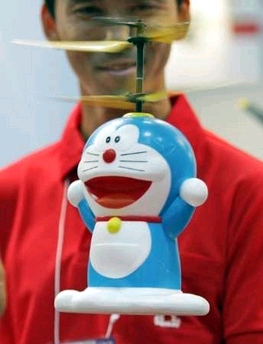
All of that may interest you, but perhaps less so than the fetching Doraemon helicopter that can be had for fifty dollars. Priorities, priorities.
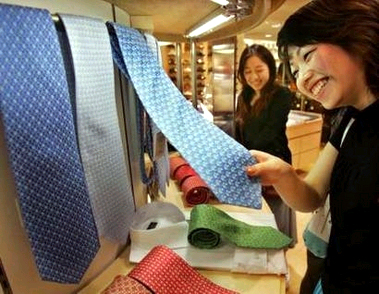
For its sagacity and legislative advances in policies both domestic and international, Japan yet subscribes to fractured doctrines of the last century — a belief in global warming on account of man the most peculiar and intrusive of them. Resting on a scientific basis as ungainly as that of every American twenty-something's fourth or fifth grade teacher, Tokyo chose the month of June to launch a campaign dubbed "Cool Biz," inviting the nation's shopkeepers and executives to keep employees' high collars, long sleeves and ties at home for the summer. Workers with less clothes could stand a warmer office and reduce carbon dioxide emissions from air-conditioners which, through the convoluted reasoning of pseudo-science, must somehow be affecting a planet whose climate has changed drastically and repeatedly without the help of modern industry.
Politics aside, "Cool Biz" has impressed neither companies with faith in uniform nor those who furnish business attire.
If not for the officious public advice and the private sector's reluctant tap dance, however, we may not have been able to learn from a string of informally polled businessmen just how thoroughly Japanese professional propriety has resisted the West's inexorable trend to formal-casual:
Employees of TEPCO put a business card-sized badge on their chests that says, "Excuse me for being casually dressed," in consideration that some customers might be offended by their casual attire. On the other hand, many workers say they feel uneasy wearing the light attire."When I have to meet customers older than me, I feel uncomfortable," an NTT East Corp. employee said. ...Even employees of companies that encourage them to dress lightly reportedly wear a tie when they leave home to avoid looking too casual in front of their neighbors and take it off when they arrive at the office.
Bless the button-down — and its accidental challenge.
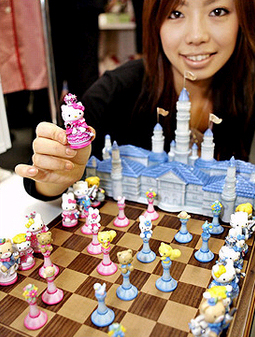
Hello Kitty is a fundament of Japanese pop culture and therefore a recurring character on uBlog's wide-eyed stroll through the North Pacific island wonderland, Only in Japan. Toymaker Sanrio recently decided to wed their lady to the ancient world, constructing a chess set in the darling feline's likeness:
Hello Kitty, the moon-faced, mouthless white cat which comes on dolls, credit cards, laptops and vacuum cleaners as a global icon of cuteness has now advanced into the world of chess. Unlike the staid traditional black and white, the two camps facing off on the Hello Kitty chessboard are pastel pink and blue...."We started with mail-order as we do not know how much demand we will see," a Sanrio official said.
Modesty. Were Anderssen and Kieseritzky alive today, we might be calling their duel the "Immortal and Highly Marketable Game."

Our fascination with Japan's fascination with robots continues. The Expo 2005 Prototype Robot Exhibition in Aichi Prefecture ended on Sunday after eleven days of synthetic marvel — from dancers to companions, surveyors to guides, laborers to entertainers, musicians to simulacrums, the Exhibition presented sixty-three robots and countless possibilities. Alongside the hardwired societal hopefuls were the ethical, aesthetic and metaphysical questions that have followed robotics through decades of straddling science and science fiction. When is a robot a supplement and a welcome substitute? When does it displace a human being who could and should have undertaken the task it performs? Are programming flaws worth the trade for man's emotional shortcomings?
 One of the robots, Kawada Industries' humanoid HRP-2, played a wadaiko based on the movements of a master percussionist like a MIDI driver might execute a sequenced musical score. Nicknamed "Promet" by its body designer, animé oldhand Yutaka Izubuchi, HRP-2 is a personified study in bipedal robotic agility, equilibrium, recovery and cooperative physical activity. Kawada intends to "rent" HRP-2 out to private and public designers alike, "a humanoid robot R&D platform" that sounds remarkably like an open-source arrangement. The Expo drum performance, likely intended for the headlines and pool photographs it duly received, does pose an interesting challenge to the human sense of musical rhythm and tempo. Mechanical timekeeping is nothing new: since the introduction of commercially available sequencers in the early 1980s, music — especially pop — has almost completely conformed to a standard of quantization, or the limitation of musical time values to a discrete set. Just as high compression is today's familiar and requisite sound, consumers' ears have grown accustomed to steady beats. A bubblegum tune without a dozen dance hall remixes is a song that will not sell, and remixing is practically impossible with arbitrary tempo fluctuations.
One of the robots, Kawada Industries' humanoid HRP-2, played a wadaiko based on the movements of a master percussionist like a MIDI driver might execute a sequenced musical score. Nicknamed "Promet" by its body designer, animé oldhand Yutaka Izubuchi, HRP-2 is a personified study in bipedal robotic agility, equilibrium, recovery and cooperative physical activity. Kawada intends to "rent" HRP-2 out to private and public designers alike, "a humanoid robot R&D platform" that sounds remarkably like an open-source arrangement. The Expo drum performance, likely intended for the headlines and pool photographs it duly received, does pose an interesting challenge to the human sense of musical rhythm and tempo. Mechanical timekeeping is nothing new: since the introduction of commercially available sequencers in the early 1980s, music — especially pop — has almost completely conformed to a standard of quantization, or the limitation of musical time values to a discrete set. Just as high compression is today's familiar and requisite sound, consumers' ears have grown accustomed to steady beats. A bubblegum tune without a dozen dance hall remixes is a song that will not sell, and remixing is practically impossible with arbitrary tempo fluctuations.
At the same time, some minimalist compositions of the late Twentieth Century, particularly those of Steve Reich, are both aurally and theoretically compelling precisely because they are live performances on traditional instruments of music normally associated with — and relegated to — synthesizers and sequencers. Metronomic and repetitive, a Reich piece like the 1970 Drumming would fail if produced electronically; on marimbas and glockenspiels, it is a seventy-minute masterpiece, wholly dependent on the happy medium between human consistency and imperfection. A friend's old college classmate was recently praised by Reich for the "tightest performance" of Music for 18 Musicians the composer had ever attended. Run through a computer there would have been no tension, no risk — and excitement is a difficult element to code. Digital clocks may prevail in the making of organized sound but the subtle judgment that brings nuance, as Kawada's HRP-2 project demonstrates, is yet beyond replication.
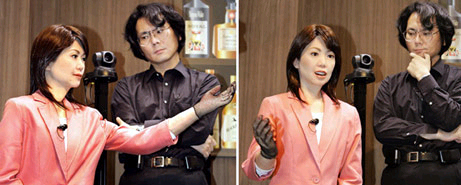
Which is not to say that robotics designers are absent their share of little victories:
Repliee Q1 appeared yesterday at the 2005 World Expo in Japan, where she gestured, blinked, spoke, and even appeared to breathe. Shown with co-creator Hiroshi Ishiguru of Osaka University, the android is partially covered in skinlike silicone. Q1 is powered by a nearby air compressor, and has 31 points of articulation in its upper body. Internal sensors allow the android to react "naturally." It can block an attempted slap, for example. But it's the little, "unconscious" movements that give the robot its eerie verisimilitude: the slight flutter of the eyelids, the subtle rising and falling of the chest, the constant, nearly imperceptible shifting so familiar to humans.
Or ethical dilemmas. How soon until Nexus 6?
UNCANNY: Repliee in motion.
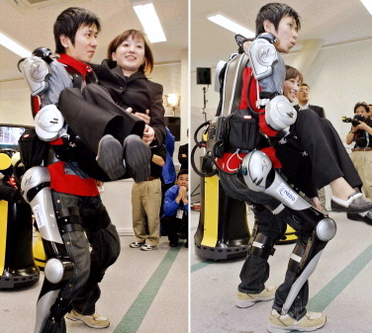
We begin with a lede and an exhilarating non sequitur:
Japan has taken a step into the science-fiction world with the release of a "robot suit" that can help workers lift heavy loads or assist people with disabilities climb stairs."Humans may be able to mutate into supermen in the near future," said Yoshiyuki Sankai, professor and engineer at Tsukuba University who led the project. ...The prototype suit will be displayed at the World Exposition that is currently taking place in Aichi prefecture, central Japan.
Physiological transcendence aside, mechanical exoskeletons have titillated sci-fi writers, readers, audiences and gamers for the better part of three decades. Christened HAL-5, the suit can both augment and stimulate locomotion, aiding the feeble and convalescent. It might even save nerds who suffer the silica-kicks of beach bullies several months of the Charles Atlas method — winning them a chance for a girl like Partner Ballroom Dance Robot, or PBDR, also at Aichi:
Japanese scientists have created a dancing robot for lonely ballroom dancers short of a partner to hit the floor with. The Partner Ballroom Dance Robot can predict the dance steps of its human partner to glide effortlessly across the room, reports Sky News.
The robot, which uses a sensory devise under its ballgown to follow its companion's steps, moves with the help of three wheels, also located under its dress. Apart from its mouse-like-ears, the android takes the form of a woman's figure, but potential partners should be warned that the robot is not light on its feet.
At 5ft 4in tall and weighing in at some 16 stone, this dance partner could inflict some pretty serious damage if it treads on your toes.
And if the evening goes sour, a slap that could likely knock a man across the floor. Still, your own monochromatic, metal-plastic composite Ginger Rogers would be a prize at a dance marathon. Do androids dream of electric fleet feet? Ask the Japanese. (Special thanks to Jonn Sokol.)
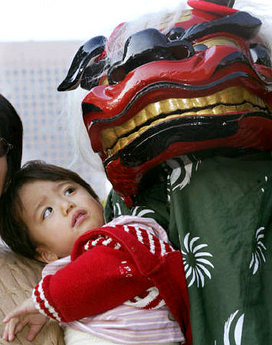
Reuters is furtively trying to tell us something.
According to Japan's Yomiuri Shimbun, the country's historically sluggish postwar birthrate has dropped even further. Now, while that may deflect histrionics from overpopulation alarmists it's done nothing to ease concerns of public policymakers:
The ongoing decline in the birthrate could mean future labor shortages as well as difficulties in funding state pensions. The ministry said the current public pension system, under which younger workers support pensioners, is unsustainable and the government may be forced to reduce pension benefits or increase premiums.
How did Reuters choose to illustrate the story? — with a lion leaning in on a watchful toddler. There's the slightest intimation that births are steady but monster-gobbling is up. A second Health, Labor and Welfare Ministry study, perhaps?
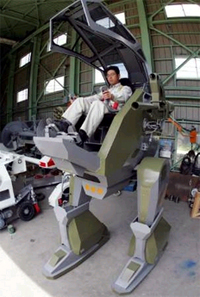
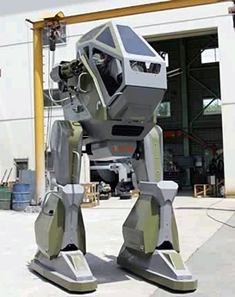
It was only a matter of time.
To even a casual observer, the robot is immediately apparent as permanent a fixture of postwar Japanese culture as the automobile and pop music are of the United States. The island nation took America's passing interest in the Robinson's Robot, Robbie, C-3PO, and R2-D2 and ran with it. Stateside children in the 1980s were deluged with Japanese cartoon programs following the adventures of human-piloted giant robots, from the legendary Voltron to the curious Tranzor Z and the moody but exquisite Robotech. American producers, entranced by the specialty transforming giant robot, offered two television shows of their own, Transformers and Gobots, each with an accompanying line of merchandise. As the decade waned, so did the novelty. When the generation that grew up watching the Super Dimensional Fortress One blast a Zentraedi fleet of calculator-busting numbers — and trying to master Rubik's Cubes like Broadside and Jetfire — stopped playing with toys, their successors took to different, if inferior, youthful diversions. The age of robots came and went.
Not so in Japan. What finds its way across the Pacific to our shores is often found tenfold over there. Would a Hovertechnics employee design a functional, russet hovercraft in honor of Luke Skywalker's landspeeder? Perhaps — though we've yet to hear of it. At Sakakibara Kikai, a national fascination landed on the drawing board:
An environment machinery maker has developed a robot that can be ridden and maneuvered like one in the animation series Mobile Suit Gundam, the company employee in charge of the development said Sunday. ...[Designer Masaaki] Nagumo, 32, developed the product over two years almost all by himself as he wanted to develop a robot that could be driven and operated to move like Gundam.
Aptly named Land Walker, the fully manual contraption tromps around and fires foam pellets right out of a ten-year-old's daydream. According to the Mainichi Shimbun, Land Walker can be had for a cool six figures but Sakakibara Kikai is happy to rent out its undoubtedly coveted services by the day. Obviously, a bipedal robot carries military potential — though Sakakibara would be prudent to consider the disadvantages of fictional counterparts. The six-story-tall Battle Pod, for instance, would require a thirty-foot-tall pilot; and the All-Terrain Scout Transport, though offering much simpler logistical requirements, performs miserably in forests boiling with excitable teddy bears armed with rocks, sticks and redwood lumber.
Until then, a few privileged Japanese children will remember a special birthday party for a long, long time.
CHIZUMANIA: I, for one, encourage Steven Den Beste to become the first man who regularly blogs from inside a San Diego-licensed, public park-trolling robot. For required additional equipment, a Raidar-X communications crest would be a nice touch. Auto body shops need a good challenge.
Want more? Kateigaho International Edition heralded the Expo 2005 Aichi with an authoritative historical account; and here, conjecture on the eternal question.

Leave it to the board of trustees of this fine weblog to compensate for what our chief officer insists is "a slight dip in production" with images and connotations that should help at least half of uBlog's readership forget all about philosophy in politics and enjoy their Friday.
In a curious trans-Pacific parallel, Japanese Prime Minister Junichiro Koizumi has, like President Bush, challenged his country's bureaucratic convention on a matter which all but the most sagacious and altruistic politicians would consider worth too little for the hefty investment of time and esteem. The trouble is ponderous, Twentieth-Century subsidy: in America, Bush moves to reform of Social Security; in Japan, Koizumi seeks subdivision and private administration of a sprawling Japan Post that, like a gargantuan zaibatsu conglomerate of old, provides citizens with everything from parcel delivery to savings accounts to life insurance. Like Bush, Koizumi enjoys a sizable if hesitant majority and a rhetorical advantage over his opponents but the prime minister has got one thing his Washington executive counterpart hasn't: a politically inclined corsetiere.
It seems Triumph International Japan Ltd. is so keen on placing the postman in the free market that the undergarment manufacturer thought it would try a memorable appeal for the private sector. Enter knockout Yu Misaki, who recently offered Tokyo fashion photographers an attractive solution for mailbox and letter carrier in one — two, rather. Triumph calls its little getup "Total Surprise Bra," complete with gratuitous exclamation point, and while the approach to grudge-match politics is novel the design and framing of argument are strikingly familiar. But it's effective. Koizumi could always use a push up in the polls, and this pledge of bipartisan support is a perfect fit.
Soccer, a whale and a crown prince in this week's standing ovation for the greatest thing that ever happened to domestic affairs.
Reconstituted, they'll make for a tasty, easily cooked meal. Suitably overcooked, some fish in Japan make for the perfect toiletry:
An ordinance prohibiting the release of black bass and other alien fish species back into Lake Biwa may help protect the lake's indigenous fish population, but it has also created a headache for locals over how to dispose of the unwanted fish. Help, however, has come from an unlikely new product, a deodorizer made from carbonized fish.Perhaps the black bass featured on the deodorizer's clever packaging sums it up best when he says, "We no longer eat crucian carp and ayu sweetfish, just odors."
What with the frustration of many American farmers and landowners, might some of this wisdom be applied to the long-ago imported avian juggernaut known as the European Starling?
Tokyo was host this Constitution Day weekend to the United Buddy Bears: six score life-size, radially arranged bear sculptures painted by artists from the country each one is supposed to represent. A traveling exhibition conceived by German artists in 2002, the Buddy Bears are intended to "[make] us understand one another better, trust each other more and live together more peacefully"; and for a rather naively symbolic exercise in geopolitical morality the Bears make for both a powerful statement of culture's craft and a sensational temporary landmark. From Afghanistan to Iraq to Lebanon to the Ukraine, each nation has an ursine stand-in. (The Russians resisted the temptation to make their final submission red.) As indicated by the photograph above, the Bears certainly appeal to young children — which can be applauded so long as tomorrow's world leaders don't exhibit mysterious predilections with foreign policies driven by fish, honey and annual hibernation cycles.
LITTLE MADRID: Switch species, replace thongs with a formidable pair of horns and we have Nagaoka's Japanese bull sumo.
Across all of the free world, long past civil wars are for cautionary plays, history buffs and costumed reenactors. Especially reenactors. Last week Japanese men and women of all ages came by the hundreds to suit up, close ranks and sprint into one another with the intention of pretending to rend anyone under the wrong banner limb from limb — as was the spirit of the times in the latter-15th and early-to-mid-16th Centuries before Toyotomi Hideyoshi unified the country under his rule.
You can't be lonely in this crowd. It doesn't exactly share the elegance of Ran, but must be good fun.
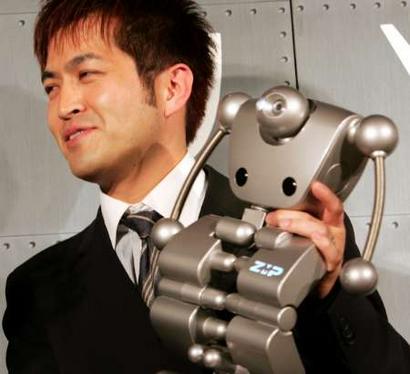
Here's robotics designer ZMP Inc. President Hisashi Taniguchi, holding one of his own Nuvo robots at an industry demonstration this past week. ZMP bills the breadbox-sized 'droid as a guardian of the home but press coverage has focused exclusively on the metal miniature's ability to dance.
Oh, how it dances. A webcam with barrettes for arms and it can massage the floor with its heels and toes until dawn — or whenever you return to the house from an errand. Nuvo responds to voice commands and can transmit image data via cellular phone bands like a mobile security camera. How a lemon-yellow sentry conceals or defends itself from a burglar who would just as well remove a witness and get some cash at the pawn shop in one grab is unknown. Presumably, the answer lies in dancing.
Confused? Perfect! This splash screen advertisement will perplex you even further. It's a full-on challenge to stuffy, bourgeois convention: do you really need to know what it does before you plunk down five grand?
So different, so alike. In following with the universal threads binding Japan and the West, we go from the transcendent to the mundane.
The crowd in uniform black was probably unfairly caught in an unflattering moment. No, no one always enjoys the early rise, the commute and the bustle but come pay day, hard work and hassles are readily justified.
If Japanese classes on children's road safety are remotely like our own, students quickly learn to be polite and courteous to their fellows, especially when driving in the play-city — but with the fleet invariably short several pedal carts, to walk a little faster and avoid being stuck with a tricycle.
Thanks to the Mainichi, we still get to revel in another world: sumo stars, Queen impersonators, stretch Coopers and a growing album of this year's cherry blossoms; this week's handshake with our one-of-a-kind, next-ocean neighbor.
It was only a matter of time: uBlog's "Only in Japan" and Steven Den Beste's Chizumatic collide when the Mainichi Shimbun's Photo Journal staff captures transpacific blockbuster animé DragonBall Z. Steven calls the marvelously terrible cartoon series his "kind of trash." I prefer Robotech but to each his own pulp, especially if it comes from the workbenches of the best.

When hunting for pictures of Japan I'm usually accosted by something respectfully eccentric or otherworldly. This scene from Tokyo is heartening in its familiarity: protesters using the occasion of bloodsoaked dictatorship Burma's "Anti-Fascist Resistance Day" to demand the human dignity sought, through threat, pain and imprisonment, by democratic champion and Nobel Laureate Aung San Suu Kyi. As explained by the Democratic Voice of Burma, Resistance Day celebrates the March 27, 1945 confrontation of invaders — a military force from a tyranny that is no more, in its place a democratic government reserving public space for this Tokyo march.
For a suitably industrious, part-time Santa Claus, it all started with such innocuity:
For centuries the Japanese have dwarfed trees in bonsai gardens which gained fame around the world. Now the delicate art is undergoing a revolution of sorts with some inspiration from Latin music, extraterrestrials and the realities of cramped apartments.The modern twist to bonsai began 20 years ago at a humble drain outside the home of Paradise Yamamoto, also known as Japan's top mambo musician. One day, Yamamoto was struck by the velvety beauty of the moss growing over the drain lid. Soon he started growing chunks of moss in a small container. When he put a miniature train on the moss, he realised something else — he no longer thought he was looking at a pot, but at a wide landscape from Japan's northern island of Hokkaido.
That's when the idea came to him: to make bonsai not just show trees, but scenes from life. Dubbed "Mambonsai," his art entails dwarfing not only trees but also statues to bring a less abstract dimension to bonsai.
The often comic results have drawn young people to bonsai, which had become a pastime largely of the elderly.
Genius being, of course, one part epiphany and two parts happy accident.
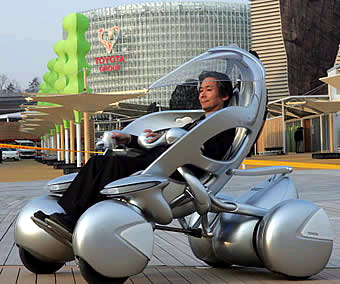
And now, the Japan you've all been waiting for. Preparing for the 2005 World Exposition, Toyota reminds us why losing a little luggage room is worth a splash of utopian chic.
College daze, allergies, bat cracks, smoothies, happy hirees and the last of winter in this week's salute to the orthodox of unorthodoxy.
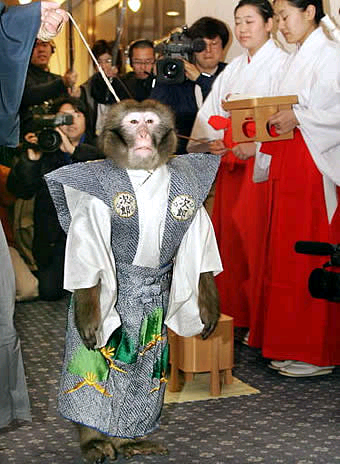
This is Jiro, Japan's prized dramatic tree-swinger, on his way to a rite of ascension.
I'd find a piquant way to express my initial speechlessness but then, as often is the case, we Americans need to offer our own little explanation.
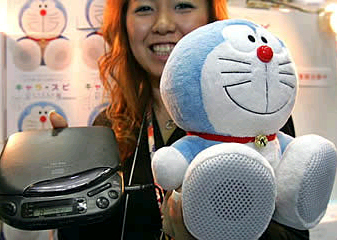
Enthusiasts of Japanese culture will occasionally be chastised by those who say that Japan is more than robots, sumo, electronics and all things youthful — including but not limited to speakers in the squat feet of "futuristic robot cat" plush dolls.
Well, now: do you trust them, or your own eyes?
Maiko, Kyoto, liquid diamonds and more from the Mainichi Shimbun's own vote of confidence for robots, sumo, electronics and all things youthful. (Note that the Doraemon speaker set is one of several novel output devices from you-know-where.)
Serious observation and commentary can be found here.
AND THEN THERE WAS DORAEMON: Robert Mayer of Publius Pundit, whom I just added to my blogroll, noted in an e-mail that he'd seen Doraemon before — but in Chile. Now, as we know, I'm just a wide-eyed Nippon neophyte, and one futuristic robot cat is any other futuristic robot cat. It turns out that Doraemon is a founding pillar of postwar Japanese pop culture, more venerable than Hello Kitty, who celebrated her 30th anniversary last year. His backstory:
Doraemon looks like an earless blue cat, but is, in fact, a robot from the 22nd century sent to assist a likeable fourth-grade knucklehead named Nobi Nobita.Doraemon, himself, is something of a bumbler, but has a front pocket from which he manifests all kinds of wondrous gadgets from the future.
Where can you find an earless blue cat that's more than meets the eye? All together, now...
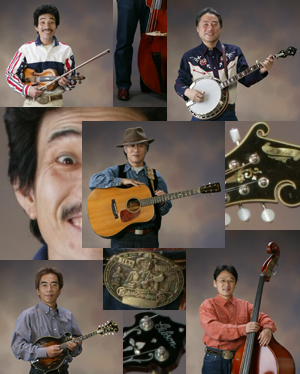
Separated by oceans, made one by baseball and bluegrass. Thank Heavens for clawhammer, string bass and the Supreme Commander of Allied Powers. (Hat tip, Idiot Nephew.)
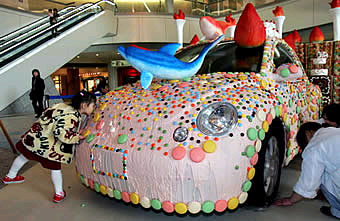
An audio recording of the corporate brainstorm responsible for the internally combusting confectionery photographed above must be a thing of greater wonder.
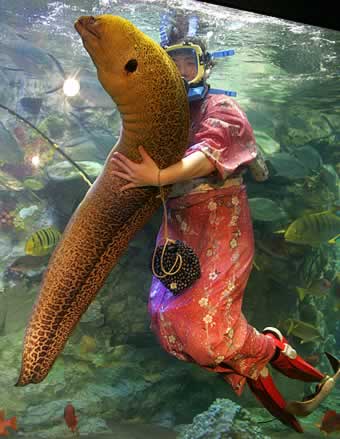
Feeding ceremonies? It's par for the course when a Japanese diver will dress up as an aquatic Kris Kringle. Then again, we've got our lore invested in Shamu.
Stand-up skinny-dips, snow to put Minneapolis to shame, and kimono-clad girls on roller coasters in this week's ceremonial tribute to glorious elegance in matchless peculiarity.
ACCLIMATION>: Baseball is more or less the national pastimes of Americans and Japanese alike. But why does a penchant for robots stay on the west side of the Pacific? Some serious questions have been raised. At the same time, we ought to pay tribute to the large-scale robotics that will save the Earth several times over.

It so happens the Mainichi Shimbun holds Japan's largest, finest and oldest eponymous competition for ornamental stenography. I found no accompanying article, but no matter: the photograph speaks volumes. 3,500 children entered their creations, part poem and part painting. To one unlettered in the Japanese language, calligraphy is simply beautiful imagery. Add meaning, and you begin to understand why the craft has endured for over a thousand years.

He's been welcomed into Hollywood's Walk of Fame: now Godzilla's doing press conferences. He's already walked the red carpet, of course.
No need to elaborate.
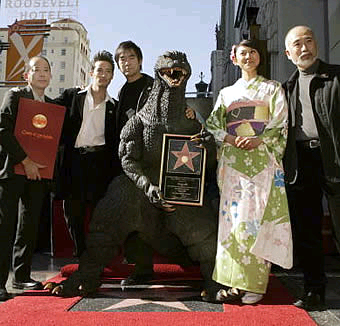
When I sift through assorted pool photographs from Japan in Yahoo Photos and the Mainichi Shimbun, I rarely need to spend much time searching for an appropriately inspiring — yet charmingly and disarmingly silly — slice of Japanese life. The image above, for example, was a winner in less than three seconds. Godzilla, fresh from a premiere of his new film Godzilla Final Wars, staking his claim to Hollywood immortality? Perfect — just don't make me see the movie.
South Korean soap opera stars, Japanese anatomical nomenclature, a bulletin-board-thriller-turned-bestseller, tickets for "Jumbo" and funny costumes at APEC in this week's tribute to all things not to be found anywhere else but — well, you know. (Godzilla trivia here.)

What do aquatic creatures and Japan's celebration of the Yuletide spirit have to do with one another? Search me, but on the uBlog it's two-for-two in documenting our Pacific island allies heralding the holiday season with friendly, frolicking cetacea (and friends).
And speaking of flippers, Japanese tiremaker Bridgestone has fitted a dolphin amputee with a rubber prosthetic fin. Merii Kurisumasu, Fuji!
Sanrio's Hello Kitty is a mainstay of Japanese popular culture and, inadvertantly but perhaps illustratively, the most frequent personality in uBlog's "Only in Japan." We've seen her charming children into riding commercial transportation and sitting for the barber; she inspires a trinket empire, fine jewelry and idols. She really has had, as they say, a wonderful life.
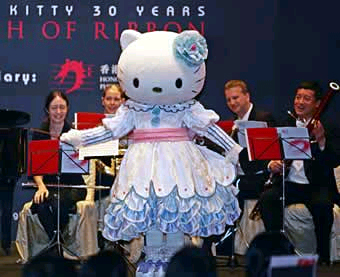
And now, on her 30th Anniversary, she accepts invitations to conduct the Hong Kong Philharmonic Orchestra. Life grabs art's arm and do-si-dos. Then curtsies.
New yen, the Japanese jet set, the Terminator in Tokyo, rooster sugarcombs and the kind of "global warming" even a red-blooded rightist could buy into in this week's sonnet to pop commercialism's Salzburg.
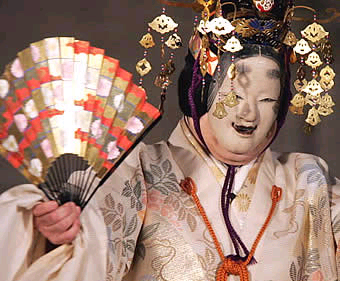
As the Mainichi explains, this Noh actor is performing Hagoromo, where one finds such dulcet passages as "the heavenly feather-robe moves in accord with the wind," printed in this 1916 translation by Ezra Pound. Here's Noh in the eyes of a devoted foreigner:
In general, Japanese Noh plays are not very dramatic, although they are beautiful, since the text is full of poetical allusions and the dances, though slow, are extremely elegant. It is this very beauty which makes Noh a living art form still, over six hundred years after it developed, and which has caused all subsequent Japanese theatrical forms to draw on aspects of Noh. Kabuki, for example, has lifted complete Noh plays into its vernacular, as well as deriving many of its technical aspects of performance from Noh.The Noh theater still speaks to audiences today, as evinced by the crowds which still rush to buy tickets for performances at the National Noh Theater, and at the five theaters belonging to the five troupes of Noh. It is a truely timeless artform, which speaks to modern audiences as it did to the noblemen and women of the Muromachi period.
Fascinating stuff, though when it comes to flashy-wardrobe stage plays in the Orient, Beijing Opera stole this neophyte's heart first. From the Chang'an Theatre:
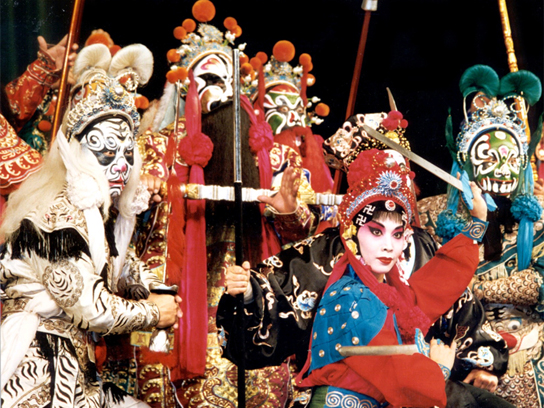
Yes, the following is a very American thing to say, but — think of the costume party possibilities. I certainly am. A little more greasepaint to scrub at the end of the night, perhaps, though well worth the impression.
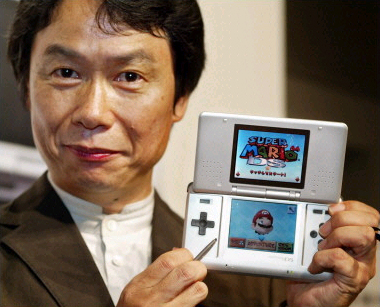
In Tokyo, Shigeru Miyamoto holds up Nintendo's new portable video game device, the DS, which is something like Johannes Gutenberg showing off a Smith-Corona. Miyamoto is the father of modern gaming, creator of hallmark 1980s titles Donkey Kong, Mario Brothers, and the Legend of Zelda series; and latter-day smash hits Star Fox and Pikmin. If you've played a video game, its designers owe something to Miyamoto.
As would be expected for often over-devoted button-smashers' golden calf, Miyamoto doesn't necessarily have fans so much as followers. Here's a biography of the genius for the sober.

Normally I offer comment to the Mainichi Shimbun's snapshots of all things Japanese but this one deserves the paper's own caption:
Masumi Gotoh, president of Japanese telecommunications-equipment company Let's Corp., explains about the company's new invention called Ka-on, that turns the petals and leaves of flowers into an audio speaker. The ka-on, which means "flower sound" in Japanese, consists of a donut-shaped magnet and coil at the base of a vase that hooks up to a CD player, stereo or TV.Place the flowers into the vase, turn on Ka-on and the magnet and coil relay the sound vibrations up the stems through the plant's water tubes.
It brings a new meaning to "audio boutique." Some advertising board is no doubt perfecting a commercial that depicts a mass of Ka-on-activated plants smashing the windows of their greenhouse in slow motion to AC/DC's "Back in Black." When Let's Corp. makes a hasta bunch put out like a subwoofer, I'll call it genius.
It's Friday, my print batch is done, and I'm off for a well-deserved falafel wrap at the West Side of Cleveland's best source of Near Eastern food that's cleverly disguised as a deli.

Is it another crash-sunken spacecraft or a very sincere investment in reinforced plexiglass? The Mainichi and those two zoo-goers know for sure, a wink at all things monochromatic and ursine; and part of this week's helping of sushi, Typhoon Number 18, Japanese road races and Pacific surf.
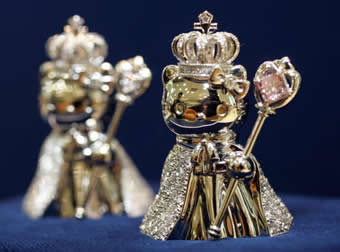
With the 2004 Olympic Games finished, my favorite tabloid Mainichi Shimbun has settled back into its daily rhythm of revealing sights you won't find in the East Pacific. Who celebrates the 30th anniversary of Hello Kitty? The same people who make diamond-studded, platinum figurines in her likeness. Not your thing? Try her in a kimono (three colors!). Surfers, racecars, volcanoes, Cold War-era hide-and-seek, Typhoon Number 16-felled trees and an Olympian tail-end are all rolled together in this week's Japanese garnet.
FROM THOSE WHO WOULD KNOW: I sift through the Mainichi like any amateur with a smattering of knowledge of Japan and its culture. Craig Brett, on the other hand, was there.

The Mainichi Shimbun is still enthralled with Japanese Olympian exploits, so we go to Yahoo! News Stories for a little Honshu peek-a-boo. While Americans enjoy harvest festivals, the Japanese tuck in for folk rituals of their own; this week's do-si-do with the Pacific's colorful — and scantily clad — democratic darling.
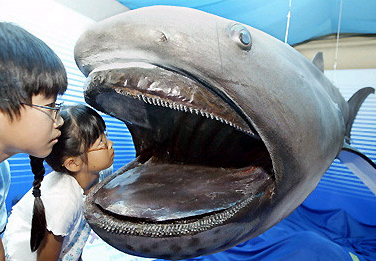
World events tend to overshadow the Japanese penchant for photogenic eccentrity, so in the wake of leftists' self-pitying protests on the 59th Anniversary of Hiroshima and this week's Olympic Games in Athens, the Mainichi Shimbun's portraits of Japanese life have been interesting but not compelling enough for the purposes of "Only in Japan." I've learned that the Mainichi draws from pool photography sources like Yahoo! News for its Photojournal feature, and while I prefer to leave subject matter selection to those who ought to know best, a three-week fast is long enough. Using the search string "Tokyo," I stumbled on not one but two photographs in all of fifteen seconds.
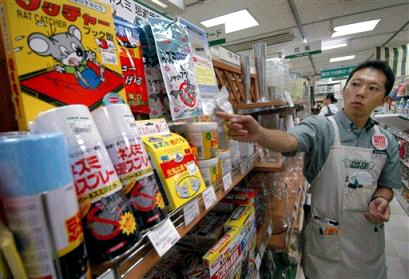
So, doubled up, we're nearly back to a weekly dose. A child's ten-minute gape at a sea creature that, if not restricted by time and place, would be pleased to devour them is indeed universal; as is the need to kill house vermin without directly confronting the methods employed, including earnest attempts at anthropomorphism. It's not the Mainichi but it's Japan, and that's exactly where we wanted to be.
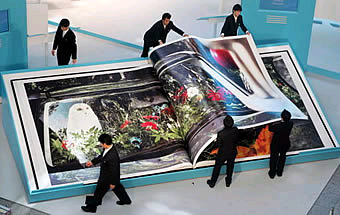
Vendors usually needn't worry about auto show-goers leaving the exhibition hall without a clutch of pamphlets under their arm. But with dozens of cars from several competitors, who says the automobile literature will actually be read and the trimline kept in mind? Mazda Motors Corporation intended their house footprint-sized book for the company's photo gallery in Tokyo. But with a colossus like that sitting next to the year's concept car, who's going to forget? That is, until every carmaker follows suit, at which point vendors can be certain that no one will be going home with the books under an arm. Bears, sumo and Japanese women filling two-piece bathing suits just as well as a Yankee girl could in this week's round trip to the place where dreams, strange dreams, are made reality.
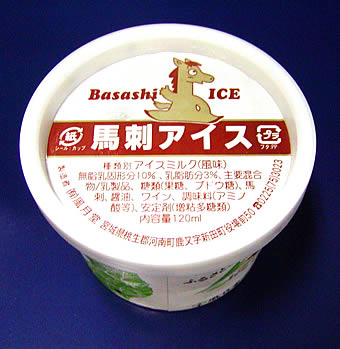
Japanese dairymen pour ice cream onto parts the glue factory didn't keep. Hilarity ensues. Ladies and gentlemen, the finest gourmet ice cream the islands have to offer. Be sure to keep your palate clean.
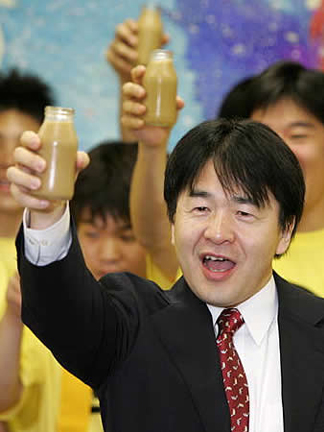
Coffee or music: which is the true universal language?
Of course, it's coffee-flavored milk depicted in the photograph — but still. Butterflies, flutter-bys, tiny Tokyo, GT vixens and Shinto nuptials in this week's invitation to Japan to come on over and share.

Busy — like I told you. I have a few responsibilities tonight but in spite of that and the temporary slow of news, some blogging could appear before long. In the meantime, head over to the Mainichi Shimbun for Venus tourist-traps, the many moods of Sumo and cherry-picking as a law enforcement duty.

Above is a Noh theater mask. Four-and-a-half years ago I read some pieces of an article in Rolling Stone on a costumed metal band whose members' shock value did much to make up for their unmusicality. The vocalist wore a sort of Leatherface mask but insisted that it was from "Japanese Kabuki. My mother used to wear it, hide behind doors and scare me." Set aside the statute-limited tale of abuse. Kabuki? The next day I happened to be at the library and zeroed in on the Japanese culture shelf, going home with an armful of textbooks and picture books on Kabuki. It turns out that Kabuki, a theatrical art form begun in the 16th Century, is primarily identified by the absence of masks used in costumery. Go figure — one man's phony story was another's introduction to Japanese culture at its most venerable, intriguing and esoteric.
Dandy actors on the red carpet, full-body tattoos, May flowers, the Japanese subsidiary for Ricola and more in this week's broadcast of the free world's most thankfully worst-kept secret.
Our first stop in Japan takes us to a growing scandal in the august and deliberative bodies of the Diet that threatens to tear apart the delicate balance of civil legislation:
Japanese Prime Minister Junichiro Koizumi scolded rookie lawmakers Thursday for reading comic books and talking on their cell phones during legislative sessions, according to a newspaper report. The national Asahi newspaper said Koizumi scolded 30 first-term lawmakers from his Liberal Democratic Party during a luncheon."Don't send e-mail on your cell phones or read comic books in Parliament while in session," Koizumi was quoted as saying.
We can better understand why the Japanese people have believed for decades that politics is sequestered from their world, indeed "the game across the street." No word on the names of superheroes whose exploits these remiss MPs were indulging in.
Skylarking greenhorns aside, Japan's power, influence, confidence and sense of moral responsibility continues to grow — and the world is beginning to take notice. The Asia Times has reviewed a book recently published by author John Nathan on Japan's broadening horizons and growing pains alike. Some of those pains include Japan's often cartoonishly brazen advertising at the expense of thin-skinned special interests. Take, for example, Great Buddha Boogers:
| One of Japan's most famous Buddhist temples is up in arms over a company's sale of sweets it calls "Great Buddha Boogers," the Mainichi has learned. Buddhist priests at Todaiji Temple in the ancient capital of Nara got snotty over the sweets, which come in a package featuring a picture of Buddha picking his nose. They successfully stopped a Nara Prefecture company from continuing to use the controversial title as a trademark by successfully arguing that it offended believers. | 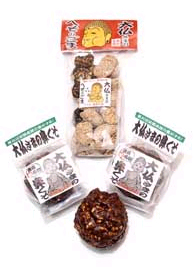 |
Never a richer, more unpredictable place. Also on the Mainichi Shimbun is this week's Photojournal, with a Japanese volleyball win, a cell phone designed for easier misplacement, Sony's nod to music as binary property and a serenade in East Timor.
Because Japanese newspapers spent most of the month of April crisscrossed with redundant reports, commentary and photography on the Wahabbist-Khomeinist-Ba'athist disruption in Iraq — including the chalkboard-raking spectacle of family members of so-called "human rights activists" and random protesters blaming the Allies for the kidnappings and violence of the very thugs whom said activists indirectly absolved in their crusade to keep Iraq dangerous, poor and undemocratic — the Mainichi Shimbun's Photojoural pages have been below uBlog standards. Now that the weeks of handwringing have passed, the general public is again treated to slices of life on the greatest island democracy that almost never was.
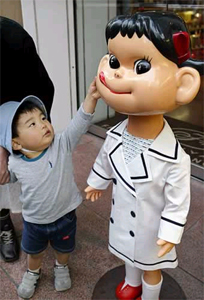
This is Peko-Chan, trademark for the Fujiya Confectionery Company; and as streetcorner mascot a prime candidate for highly portable, collectable kitsch. Her kidnappings are a sort of urban tradition. Elias Brothers, know that you are not alone. (Or for that matter, Big Boy. Hey, Peko, do I know a fella for you. Hardworking. Good cook. Er, what do you think of pompadours? )
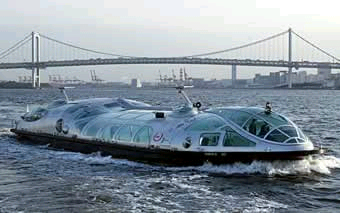
Yes, it's been some time since my last look into our unique capitalist friends across the Pacific — of course, Japan is never not interesting, so you can pop over to the Mainichi and be amazed and astounded any time. Today, we go maritime. When Leiji Matsumoto isn't blazing a masterful trail for Manga and animé, he's apparently inspiring 114-ton ferry boats for use in Japan's metropolitan waterways. The Japanese are no strangers to adding a science-fiction twist to ordinary life but the Himiko, which begins service today, is a pure act of eliminating every last bit of non-stylishness to the country. After one look at this metal, winsome beauty, can you blame them?
Political steps taken over the past several months by the Japanese to bolster their military and strengthen their diplomatic resolve - not to mention the recent court decision to hang cult killer Shoko Asahara - have convinced me that the country is moving inexorably towards confident international stature and sensible domestic polity. Moving inexorably if slowly, that is.

Yes, ladies and gents, that's ""Nippon Seaman Ship, Seaman Ship, For Love...For Peace." The marketing division responsible for this call to arms (outstretched, gaily, while twirling) was convinced that peace through strength of arms could be promoted with levity. And, from the looks of the photograph, superb dance choreography. Has the same advertising agency been working on a public image boost to the Young Men's Shinto Association? This week's Photo Journal doesn't say, but offers insight on 360-degree realtime imaging, paper mâché rhinos, digital snappers and tennis players indulging in tiaras while overseas. Take a look.
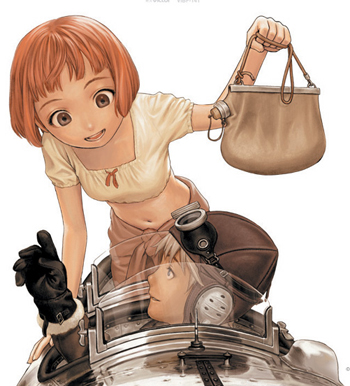
My buddy Ed ought to be a Japanimation salesman. He's hooked me, a non-enthusiast, to his latest find: Last Exile. What could possibly be better than an animé series devoted to the soap opera of charismatic teenagers battling in repulsor-driven airships from a would-be 1920s? Said animé series that, without your even watching it, lends itself to ColdPlay's hit "Clocks." Can you hear it? Send a memo to the marketing department.
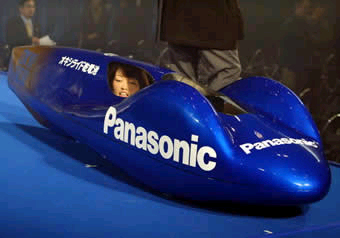
In the West, beautiful, lithe women are made to be models and paraded around in all manner of revealing attire. In Japan, beautiful, lithe women are made to be models and stuffed into coffin-sized, dry-cell-battery-powered, rolling lozenges. I'd end this with a platitude like "You can't account for taste" but you know, they're really stretching it.
On the serious side, the Mainichi Daily News has collected two heartwarming photographs depicting the first Japanese deployment since the Second World War, and we can see a Japan worlds apart from the one the Allies defeated and rebuilt:


Back to Japan, land of unique tastes. Cherry blossoms, Prime Minister Junichiro as a Bronx Bomber and reckless chocolate abandon on the other side of this link.
GET 'EM WHILE THEY LAST: As I noted a couple weeks ago, the Mainichi culls independently produced photographs for its PhotoJournal series, and I could not find archives from a given week as I could with Photo Specials. Having traded correspondence with an editor, I now know for sure that the Mainichi does not keep PhotoJournal archives; so whatever is online this week will soon be relegated to either the flotsam of pool photography or obscure, cherry-picking bulletin boards. Understanding that full credit would be given, I'm contemplating archiving each week's photos myself. We'll see.
As a child I used to read a Japanese mythology-inspired book, The Dream Eater, but this is entirely something else:
[Takara's] Yumemi Koubou works by first relaxing you; lulling you to sleep with soft background music, mood lights, and a "pleasing" fragrance. Once the mood has been set, it's your turn to respond. To solidify the dream content, according to Takara, you need to record one simple, concise summary phrase with the built-in recorder. Make it a good one - this phrase will be repeated throughout the night quietly while you're sleeping.With knowledge of a standard eight-hour sleep schedule, the device activates periodically during your REM sleep cycles, giving gentle reminders of the desired dream content (in other words, more music, fragrance, and replaying your recorded phrase).
In a written statement, a representative from Takara states, "… this product is designed to help people shape their dreams in sleep, combining multi-sensory stimulus and sophisticated sleep-dream research to create an environment conducive to having a specific dream desired by the user."
A repeated phrase, eh? If this were scientifically sound, the phrase could be theraputic - or used for indoctrination. That reminds me of an old instructional tape used to maximum ironic effect on MTV's early 1990s Liquid Television: "You love to bowl. You love to bowl. You love..." The Yumemi Koubou's worth at least half a gander, especially since Takara are the same people who brought us the Bow-Lingual dog translator.

I knew that a fellow - named Konishiki - was a Hawaiian-born sumo champion in Japan. What I didn't realize is that his taste in women is admirably, er, down-to-earth.
Kimono flappers, flaming grass and the ultimate polar bear swimming in today's wide-eyed stare at the Pacific culture we're all better for at least trying to comprehend.
On another note, this Orient bulletin board seems to have an archive of Mainichi Shimbun's Photojournal, if irregularly. You'll notice that the daily Photojournals to which I link (not the Photo Specials) are no longer accessible, replaced by the latest set of press snapshots. I've yet to find an official archive for daily Photojournals (not Specials) - there may be none. So this might be a nice resource if you spy a picture in my category archive and want to see some of the other photos I reference.
Have you ever given any thought to making foreign friends - if you have any and if not, how to go about it? As an American, probably not; but then, you might if your country were historically isolationist, eschewing contact for two hundred years with all Western nations but the Netherlands. Judging from the responses in Japan Today's man-on-the-street canvassing, the question asked isn't an outlandish one.
Slow news day? Tell me about it. A promising Afghan constitution has survived debate; terrorists in Iraq are losing men, arms and confidence by the hour; much of the world has settled back down into day-to-day business (which is welcome, unremarkable as it may be); Spirit has yet to start roving to discover or photograph anything surprising, shocking or stunning; even the Corner is throwing cards into hats, debating on the meaning, origin and social significance of the term "neoconservative."
Ah, but the humdrum stops short of distant shores, as Japanese firemen perform 300-year-old, acrobatic stunts for the benefit of an eager, taxpaying public:
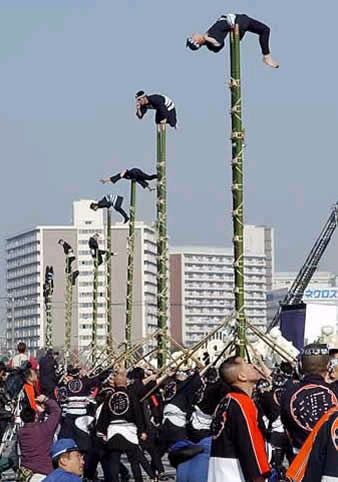
The December 2003 issue of National Geographic ran a story on Japan that included a photograph of firemen: even their uniform designs - shaped like samurai armor - are throwbacks to history. Impeccable service notwithstanding, American fire departments could learn a thing or two about color. Truant sumo, bullet trains on closed circuits, calligraphy bees and more are in this week's head-tilt-and-sigh for the nation ranking third in economic power and first in quirky style.
If people don't stop pestering the Osaka police department, they'll, er, call the police:
The number of prank calls to police in Osaka has drastically increased this year, averaging about 490 a day, officers say."We have no choice but to ask the public to use the emergency hotline to police properly," said an officer from Osaka Prefectural Police. "We may even arrest persistent prank callers."
Officer, let me introduce you to the concept of "filing a false report." You won't regret it.

This cheery merchant is briskly selling his battledores - rackets used for the New Year game Hanetsuki - at the Hagoita Ichi fair, but for those of us somewhat distant from Japan's shores, battledores can be purchased online by import dealers. As one kindly explains:
This kind of decorative battledore is used for home or shop decor. Man's face is used as bringer of good luck for business, and a lady's face as a festive decoration. A big battledore fair is held in [the] Asakusa [district of] Tokyo before the New Year. These battledores are [made] to look 3-dimensional on the Paulownia wood base by using polystyrene foam covered by real kimono fabric.
If you're close to both a Japanese enthusiast and sixty dollars*, the battledore looks like the perfect gift for sport and show.
Battledores galore, citron bathing in the wintertime, skiing champs, Sony robots shamelessly authorizing unseen field goals and more in this week's knowing, ear-to-ear grin at one of the most exciting Pacific cultures around.
(*Or cheaper somewhere else, and I've no idea as to the vendors' credentials.)

Believe it or not, drawing children into the world of grooming through cartoons and toys is old hat in America. Twice or three times, my sister and I were taken to an establishment called Fantastic Sam's that operated on the same principle as this Japanese example: keep the juniors occupied with animated shorts, ensure that they go happily out the door with a free toy. The gimmick worked its charm, though it wasn't worth a terrible trim my sister eventually received from a flamboyant stylist named "Skipper." No plaything is worth a bad bob. So my folks returned us to the traditional, austere world of barbers (though the fellow we used at the time, Dave, played some wiseacre games with his photo-identified, wall-mounted credentials).
But of course, she wasn't surrounded by Hello Kitty - which brings us back to the H.C. Studio in Yokohama. Broaden your knowledge of modern hairstyling, snow monkeys, pickles, Koizumis protesting Koizumi, and more in this week's approving glance at the North Pacific's third-level mini-boss.
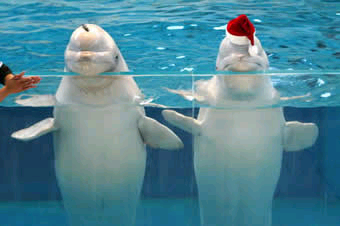
With the celebration of Thanksgiving comes the old Macy's Thanksgiving Day Parade, where jolly old Saint Nick rolls into Herald Square before signing papers to authorize the official Beginning of the Christmas Season (and least that's what I've been told). Central planning from North Pole corporate suits aside, some parts of the globe are just as enthusiastic to celebrate their own interpretation of the season. Japan is no exception. See Tokyo's one-time, radioactive reptilian archenemy in lights and a pixie-like spirit in white-trimmed, red woolen whose, er, distinguishing characteristics suggest a misreading of the world "Santa" somewhere along the line; all in this special holiday hat-tip to modern democratization's most eccentric client.

Expect a Japan political news roundup tonight or tomorrow (I don't expect enough time tonight, so count on tomorrow). Until then, read all about a sumo superstar in the Mainichi Shimbun's own Pacific 411.
OH, OKAY: I'll have it together at some point this weekend.

The adage goes like this: leave out the eggs because you'd like to try it differently, and you bake a poor cake. The same goes for modifying election laws from the more successful standards set in America and Britain. Yesterday we gave Japanese politics a quick glance in anticipation of Sunday's general election. As it is, foreigners may be looking forward to the event more than native voters - and only then marvelling at Japanese disinterest:
Japanese politics and elections lack the kind of spectacle, political enthusiasm and festivities that one witnesses, for example, in the United States during presidential elections or in countries such as India, where almost everyone becomes immersed in politicking at general elections. In Japan, fewer people turn out on an election day as trust in politics and politicians remains low.
William Chapman, former Tokyo bureau chief of the Washington Post, describes traditional Japanese campaigning:
In most democracies, political campaigns are thought of as vehicles that draw citizens into politics. In Japan the campaign is yet another example of how the system has come to insulate people from politics. The word campaign is here used advisedly, because it bears little resemblance to those in other modern democracies. It consists in large part of scenes like this: A car mounted with loudspeakers moves slowly through a neighborhood street. A smiling man, the candidate, waves at passing pedestrians, his white-gloved hand extending through an open window (the white glove being a symbol of purity). From the loudspeakers comes the shrill voice of a woman (a campaign aide) shrieking, over and over, the candidate's name and the greeting, "Doozo Yoroshiku." And that is the biggest part of the political campaign in Japan.
Chapman goes on to list the myriad regulations that effectively prevent a politician from spending any appreciable time with the electorate; presenting his platform, discussing issues, connecting with the population. As of 1991, when Chapman's book Inventing Japan was published, even door-to-door walks were illegal. Under such restrictions, the grassroots potential is nigh well impossible. Where Japanese authorities sought to limit corruption and stamp out extremism - laws set by the Occupation were far, far more lenient and reflective of America - they have created a lifeless cycle of popular election.
Most frustratingly of all, it seems that, absent a sweeping public outcry, only the most brazen populist could hope to challenge election laws. As with any campaign law restricting free speech, incumbents benefit enormously; and incumbents are the men and women writing the laws. Liberal Democratic Party members would have little motivation to destroy the systems that support entire political careers.
Need Japan's domestic woes become severe before the country reassesses its deep electoral flaws? Even if that's the case, a minor calamity would be worth better, more competitive elections whose winners could bring about some palpable reform. Observers, however, believe that an opposition-party victory by the Democratic Party of Japan could throw just the right amount of cold water on the Diet - so Mr. Mitsunori Okamoto above had better get peddling.
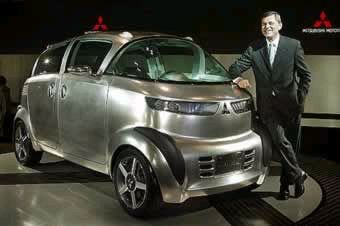
Last spring I attended my first American auto show in years, and was wowed by a sleek concept car from Lincoln; its body was straight out of Blade Runner, the interior's upholstery heavily borrowed from 2001: A Space Odyssey. But it was the only engineer's side project to see there. Naturally, the Tokyo Motor Show 2003 is stuffed with cars of one man's tomorrow - from the gorgeous to the utilitarian to the bizarre, to the polished metal sunflower seed with wheels. All that and more in this week's peek at the Pacific's own Best of Show.
BONUS: We all knew that Flash animation would eventually arrive at staggering artistic heights. And that the triumph would be all Japan's. (Thanks, Patrick.)
COINCIDENCE?: Unbeknownst to me, Lileks made a random reference to H.G. Wells today, too. I'm guessing the seed was planted a few days ago when Glenn Reynolds linked to a blogger comparing the present conflict to The War of the Worlds.

A whirlwind weekend it was that ended, today, with a whirlwind day.

A stay at Ed's is always a pleasant and educational journey into worlds somewhere between Wired and Game Pro magazines (with a healthy dose of Reason). Rain on Sunday only increased the odds of console-gaming competitions indoors.
The Sandman has got me in a wrestling move - the Sleeper, as a matter of fact. I'm going to relent, give dreamland seven or eight hours and write a blog-worthy Albany lowdown tomorrow.
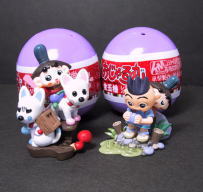
Remember the fifty-cent capsule toys you'd beg your mother for on the way out of the grocery store? Like most of childhood, the irresistable urge to buy every toy in sight miraculously precedes your possession of money. Gooey, green slime and a bright yellow water-growth gargoyle are my most memorable grabs; well-worth the dollar wasted, er, invested between the two.
Nostalgia alone couldn't draw my wallet out for capsule toys - but, as usual, I can't speak for the Japanese. And they've conveniently removed the vending machine middleman:
About two years ago the Japan Toy Association created a new "capsule toy" division and began collecting statistics on the goods. Last year's capsule toy market totaled 26 billion yen a year, according to the association's figures. That was 24 percent higher than during the previous year.A lot of the toys that are being produced are based on themes from the '70s and '80s. Bandai, the biggest producer of capsule toys, brought out its "my elementary school" miniature toys in November last year. Since then, a total of 2.4 million toys from three series have been snapped up by customers. The figures included school backpacks, school lunches with milk, and familiar school notebooks. Many of the customers were reportedly women in their 30s.
Yujin, another major capsule toy maker found success with its "science and learning mini collection." Within two weeks of the release of the series last year 300,000 toys were sold. Although the toys are no bigger than the palm of a person's hand, buyers can actually perform experiments with them. Also well received were capsules containing sets to raise the tiny marine creatures known as Sea-Monkeys. These products drew in male customers in their 20s and 30s.
Of course, chance is what made the capsule purchase fun:
In the past, capsule toy machines were generally used to fill empty space in stores, but since enthusiastic capsule toy fans now often buy whole sets of toys, it is not uncommon to see leisure facilities or supermarkets lining up as many as 100 machines. The Gachapon Kaikan store in Akihabara has 300 dispensers.
We should expect a country with scarce real estate to teach us, once again, that the best goodies don't always come in large packages.

It may have less flair than windshield-wiper glasses, but Japanese sparrows are apparently scared to death of umbrellas - so discovered a farmer who was at the end of his rope searching for the perfect scarecrow. We'll keep an eye out for somebody swooping in to patent it. All that, Edo monuments, spaceman robots and more in this Friday's hat tip to the world's most enjoyably eccentric democracy.
What's a treat from the West without a twist from East? Now, we've all heard rumors about Japanese ice cream. The Mainichi Daily News actually canvassed the product line. Read on - you might develop an appreciation for the ever-ordinary French Vanilla.
And we thought it was only good for July picnic grills and cooking derivatives:
The world's first environment-friendly optical discs made from corn will hit the market from December this year, a Japanese manufacturer has announced.Officials of Sanyo Mavic Media Co., a subsidiary of electronics giant Sanyo Electric Co., said they have found a way to manufacture 10 high quality compact discs from a single corncob.
Named "MildDisc" by Sanyo Mavic, it is equal to conventional plastic optical discs in quality and produces no dioxin or other hazardous material when it is burnt. Moreover, MildDiscs can be degraded into the [soil harmlessly] by micro-organisms.
If this technique is adopted industry-wide, consider the benefits: farmers are given access to another market while the relative abundance of corn knocks record prices down even further than the latest Universal attempt at making nice with consumers. Yes, ladies and gentlemen, The Magic of CornTM could put to rest archaic subsidies and illegal file sharing in one agrarian-space-age stroke!

Urban transportation with style - Japanese style. Who cares if you're stuck in traffic and the meter's running when you've got Hello Kitty accessories to play with? Here's your weekly dose of the country whose culture regularly gives America a run for her money.
ALSO: A taste of Japanese mythology and a tourism leaflet, all in one.

Busy today, so light blogging is in order. (And that's truly light blogging, as opposed to the World's Most Energetic Blogger. This one lifted an eyebrow; Sullivan picked up on it, too. And this morning IP's apparently "making up" for the purported lack of posts. Unstoppable.)
I watched about a third of the Democrat presidential debate last night. No, of course I'm not going to vote for any of them - but I came away with a few observations beyond agreeing with Buckley's assertion that piss-and-vinegar campaigning will lead Bush's challenger to certain electoral doom (Moseley Braun's still peddling the "selected, not elected" line?). More later.
For your diversion: sights and, er, more sights from Japan. The Mainichi Daily News is clever with its teasers drawing in foreigner culture enthusiasts. Parade? Men in ancient garb beating drums? I'm there!
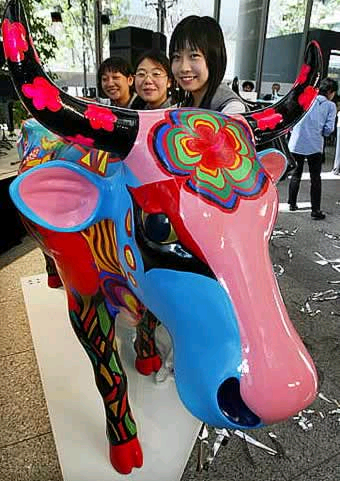
It's for the "CowParade Tokyo," you know? Japanese pop culture and more in this Friday's peek into the land of Sumo and video arcades.
ALSO: I found this fellow's photo diary accidentally. Fascinating.
Remember Gary Larson's The Far Side daily with the angry dog owner scolding his dog Ginger - the dog's translation of which was, of course, "Blah blah blah Ginger, blah blah blah blah Ginger"? Care of our inventive, Pacific brothers, you too can play Han Solo to your dog's Chewbacca:
With the US release of the Bow-Lingual, Japanese Toy manufacturer Takara Corporation tackles what we'd call the little known 'Dr. Dolittle Market' (i.e. the people who want to talk with the animals). The Bow-Lingual aims to translate "dog" into "English" - converting simple dog barks into phrases printed on the unit's small, portable LCD screen. It's ingenious, innovative, and interesting - but somewhat flawed.
Part of that flaw, explains the article, is that dogs aren't exactly enigmatic or worth $100 of United Nations-style translation. Read on.

